Art & Exhibitions
Berlin Biennale Presents an Art World Spread Too Thin
We review the eighth edition of the biennale.
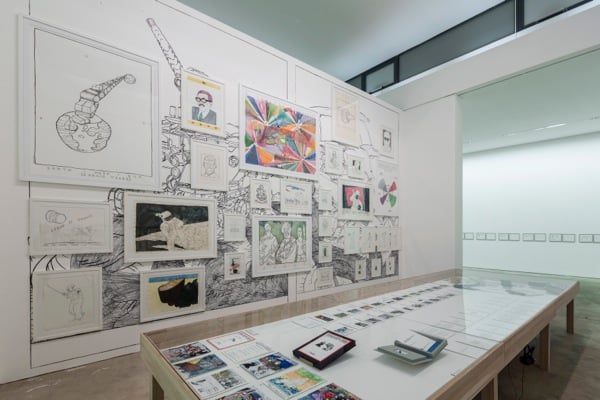
We review the eighth edition of the biennale.

by
Alexander Forbes

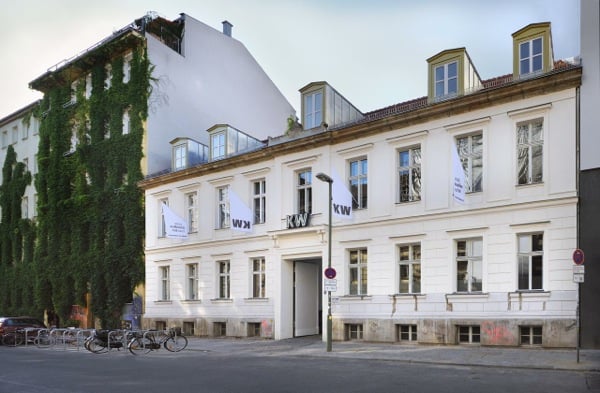
KW Institute for Contemporary Art
Photo: Uwe Walter, 2010.
The 2016 Berlin Biennale has some serious promise. That is, because its 52-artist-strong eighth iteration curated by Juan Gaitán, which opened Wednesday night, is such a monumental overcorrection from Artur Żmijewski’s before it. In 2012, Żmijewski invited Occupiers of varying stripes to live and create in the KW Institute of Contemporary Art. While bold in its intention, the show highlighted an already-stale art as protest trend and was near-unanimously considered a flop. This year, Gaitán has curated a too-safe show that riffs too heavily on the critically lauded themes of the archive and marginalized art practices we saw at Carolyn Christov-Bakargiev’s Documenta and Massimiliano Gioni’s Venice Biennale. It’s the kind of work that I truly enjoy. It’s the kind of work that I want to continue to see more of in major institutional presentations. But by now, as a biennial exhibition concept, it disappoints.
Gaitán’s biennale is spread over three venues: its traditional center of KW, the Haus am Waldsee (built as a private mansion in 1922 and serving as an art center since 1946), and the Museum Dahlem, which is also Berlin’s Ethnographic Museum and continues to fulfill that purpose with biennale works scattered amidst its offering of artifacts. The latter two are located in the petit bourgeois suburbs of city’s far southwest corner where the art scene rarely ventures. (You can read more about Gaitán’s choice of venues here.) It was my first time to both.
The recommended path through the exhibition starts at the Haus am Waldsee. Its first room, and one above it, the so-called Private Collection, is the biennale’s most esoteric presentation. While not qualified in any way within the biennale’s literature the section is something of a mood board for Gaitán’s show, a fantasy collection of unlabelled works by artists such as Jimmie Durham and Monica Bonvicini. The two spaces, one on each floor, are also meant to reference his wish for this particular institution to serve as an investigation of art in the private realm. However, it comes off as a copy and paste of Christov-Bakargiev’s “Brain” in Kassel’s Fridericianum and an only half-baked copy at that. (Aside from his artistic sympathies, Gaitán also nicked her heavy use of brackets in the exhibition’s visual identity.) The Haus am Waldsee is the biennale’s low-point, though Slavs and Tatars’ large sound installation, Ezan Çılgınnnnnları (2014), which consists of a large metal book buried in a grassy mound in the museum’s rear lawn was a bright spot.
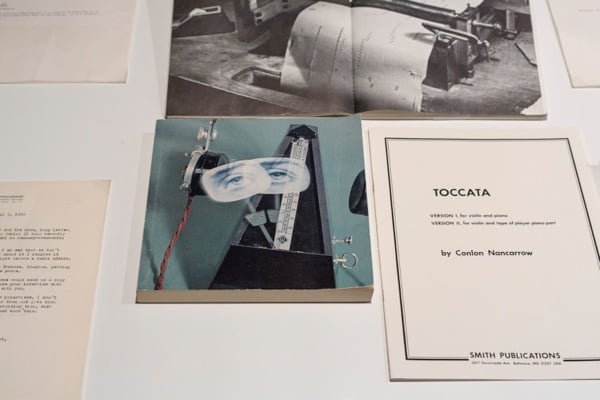
Mario García Torres, Sounds Like Isolation to Me (undated) installation view Berlin Biennale
Photo: Anders Sune Berg, courtesy Mario García Torres; Proyectos Monclova, Mexico City; Jan Mot, Brussels; neugerriemschneider, Berlin.
At the Museum Dahlem there is more to like. That is, if you can find the works. Gaitán spread them through the museum’s ethnographic exhibitions, in three main clusters and a few outliers. With any luck and some guesswork those main clusters are fairly easy to navigate. But to find a particularly bijou mini-exhibition Double Lives by biennale artistic advisor Natasha Ginwala—it proposes a dinner conversation between 19th century figures like Emma Hart Willard and Emin Pasha via archival materials—I circled the “Muslim World” twice only to find I was on the wrong side of the museum and to repeat the exercise through a labyrinth of Chinese ceramics. A little signage would go a long way, guys.
Navigational difficulties aside, another archive-oriented display, Sounds Like Isolation to Me (undated) by Mario García Torres is the Dahlem’s highlight. For it, the Mexican artist takes up the legacy of Conlon Nancarrow (1912–1997), a leftist American composer who lived in self-imposed exile in Mexico. He garnered great acclaim among his contemporaries: Rene Block and John Cage were fans and letters between them and Nancarrow fill one long vitrine. But Nancarrow lived in relative obscurity due to his composing mainly for player pianos in what he called a style of temporal dissonance. Several of those player piano cartridges are also on view.
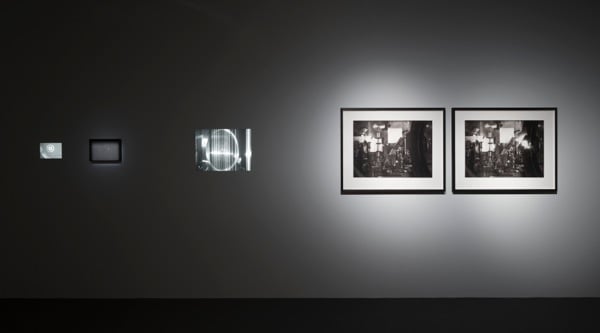
Tacita Dean, 10 to the 21 (2014), Installation View Berlin Biennale
Photo: Anders Sune Berg, courtesy Tacita Dean; Frith Street Gallery, London; Marian Goodman Gallery, New York/Paris.
Video was particularly strong at the Museum Dahlem, and the biennale as a whole. Rosa Barba’s installation Subconscious Society (2014) was, of any work in the biennale, the best take on Gaitán’s intended critique of image-based culture. It shunned the digital entirely in exchange for a massive 35mm spool and pans of liminal land- and cityscapes such as that of a British, former manufacturing zone. Half of Anri Sala’s acclaimed installation from the French pavilion at the Venice Biennale last summer UNRAVEL (2013), which watches the hands of a woman DJing LPs of classical music was equally good without its RAVEL companion. Carlos Amorales’ The Man Who Did All Things Forbidden (2014) is a sharply humorous take, debunking the myth that culture is harmed by those who break the rules. Tacita Dean’s 10 to the 21 (2014), an investigation of the possibility of filming lab tests of ‘nano-nuclear-equivalent’ explosions might as well have been its own solo show.
It’s works like those that surround Dean’s installation that best demonstrate what’s wrong with the biennale, however. Naïve drawings by Gordon Bennett, Gaganendranath Tagore, and Ganesh Haloi are by no means less interesting in isolation than some of the established positions in the exhibition–to the contrary. But, their encyclopedic onslaught was all too familiar, bringing one right back to the Central Pavilion of last year’s Venice Biennale.

Tonel, Commerce (2014) Installation View Berlin Biennale
Photo: Anders Sune Berg, courtesy Tonel.
Likewise, KW’s main hall. Gaitán has placed two walls within the cavernous space to create three mini-exhibitions of works on paper by Irene Kopelman, Tonel, and Mariam Suhail. Ironically, the hanging undoes his conceived placement of the KW as the one unmediated space for contemporary art, instead giving the most residential viewing experience of any of the three institutions, despite the room’s size.
To be fair, however, the rest of the building rounds off the biennale with an upward turn. All’s well that ends well, so they say. Artist-of-the-moment Otobong Nkanga’s video and mixed media installation In Pursuit of Bling (2014) is a wry yet touching take on the myriad uses of the mineral, mica. A series of works from Li Xiaofei’s ongoing video project Assembly Line (2010- ) are some of the best takes on the realities of labor (in this case manufacturing in China) that I’ve seen in quite some time. They’re also some of the most simple: a single man watches a dingy conveyor belt pass by him, another laying on a bench as if taking a quick nap, a group chatting idly on the factory floor. Working becomes waiting.
On KW’s second floor Julieta Aranda’s Stealing one’s own corpse (An alternative set of footholds for an ascent into the dark) (2014) takes the prize for the single best work across all three institutions. The installation features various forms of traps and snares, all painted white and placed on a blue carpet like so many clouds. A video plays on the far wall, documenting individuals who seemed to have signed up to colonize Mars and her own experience of zero gravity. The piece is pointedly critical of our capitalistically driven need to acquire and accumulate. It drove us into space in the first place, she posits. But it’s the work’s more forward-looking critique that most impresses: the very absurdity that, in space, an utter vacuum where existence never mind possession is impossible, we’ve managed to transport rather than transcend those very same earthly politico-economic snares. Aranda’s is one of only a very few works in the biennale, if not singular, that felt both bracingly of this moment and offered something to art that was, well, new.
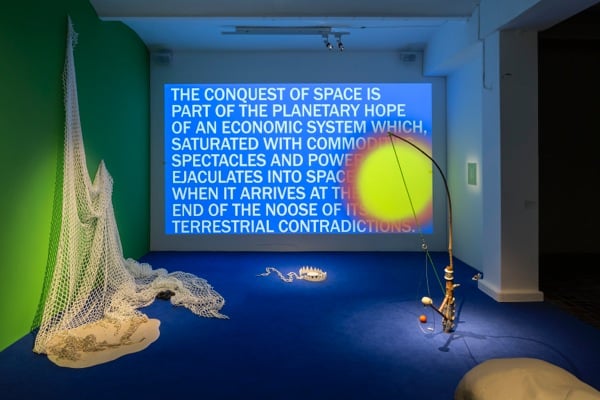
Julieta Aranda, Stealing one’s own corpse (An alternative set of footholds for an ascent into the dark) (2014) Installation View Berlin Biennale
Photo: Anders Sune Berg, courtesy Julieta Aranda.
Despite the fact that artists produced 80 percent of the work seen across the biennale specifically for the show—its secondary selling point, aside from the locations’ novelty—very little in it feels fresh. Very little urgency or mandate comes through most pieces. It’s a fact that reflects a larger art world conundrum: as we continue to increasingly frame artistic labor within the same constructs as we do that of other object-producers (i.e. productivity and output targets) quality or at least (and perhaps more crucially for the future of art) resonance falls dramatically.
I’m loath to bring discussions of market pressure into the critique of a biennale. But heavy productivity pressure—the need to produce work for X number of fairs, X solo and group exhibitions, and X biennales for the luckiest artists in our field—reads through between a number of the works in the biennale, over reliance on commissioning as well. Both almost inevitably mean that what is produced goes grey in its imminent relevance. Ideas can be ordered up—it’s a practice we’ve seen used to varying degrees of success by curators since the 90s—but more often than not, their spontaneously generated counterparts hit harder. (They also fail harder, which is a good thing for art at large.)
This eighth Berlin Biennale has no real failures. But it has very few successes as well. It’s heavily mediated—and poorly managed. The artistic approaches are highly symptomatic of the kind of engineered conceptual art that communicates with its viewer by very precisely hitting intellectual pressure points. By doing so it reveals too easily the brief (or the “ongoing intellectual discourse” as Gaitán put it) that lead to its creation. What’s more, all that talking didn’t create an exhibition that, in any clear way, serves up Gaitán’s thesis either. It’s neither grounded nor weightlessly suspended in creative chaos but rather some kind of silt.
Sitting at a bar following the preview with a group of fellow critics, all non-Berliners who had been here on the range of 15 years to four, a strange, if also sad, conclusion was reached. In the end the biennale is actually a pretty good reflection of the city at large in this particular moment. Berlin is neither the experimental hub it once was or the true art capital it might become years down the road if capital continues to flow into its limits. For at least two in our group, however, the prospect of waiting that time out was too soul crushing to bear. The only question, as one put it, “but where to go next?”
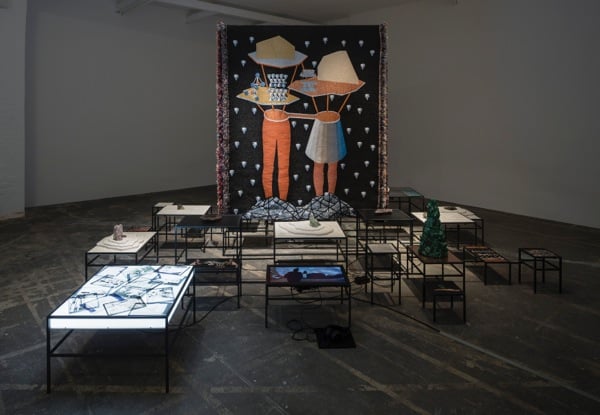
Otobong Nkanga, In Pursuit of Bling (2014) Installation View Berlin Biennale
Photo: Anders Sune Berg, courtesy Otobong Nkanga.